AUDI A5 COUPE 2018 Owners Manual
Manufacturer: AUDI, Model Year: 2018, Model line: A5 COUPE, Model: AUDI A5 COUPE 2018Pages: 409, PDF Size: 67.63 MB
Page 261 of 409
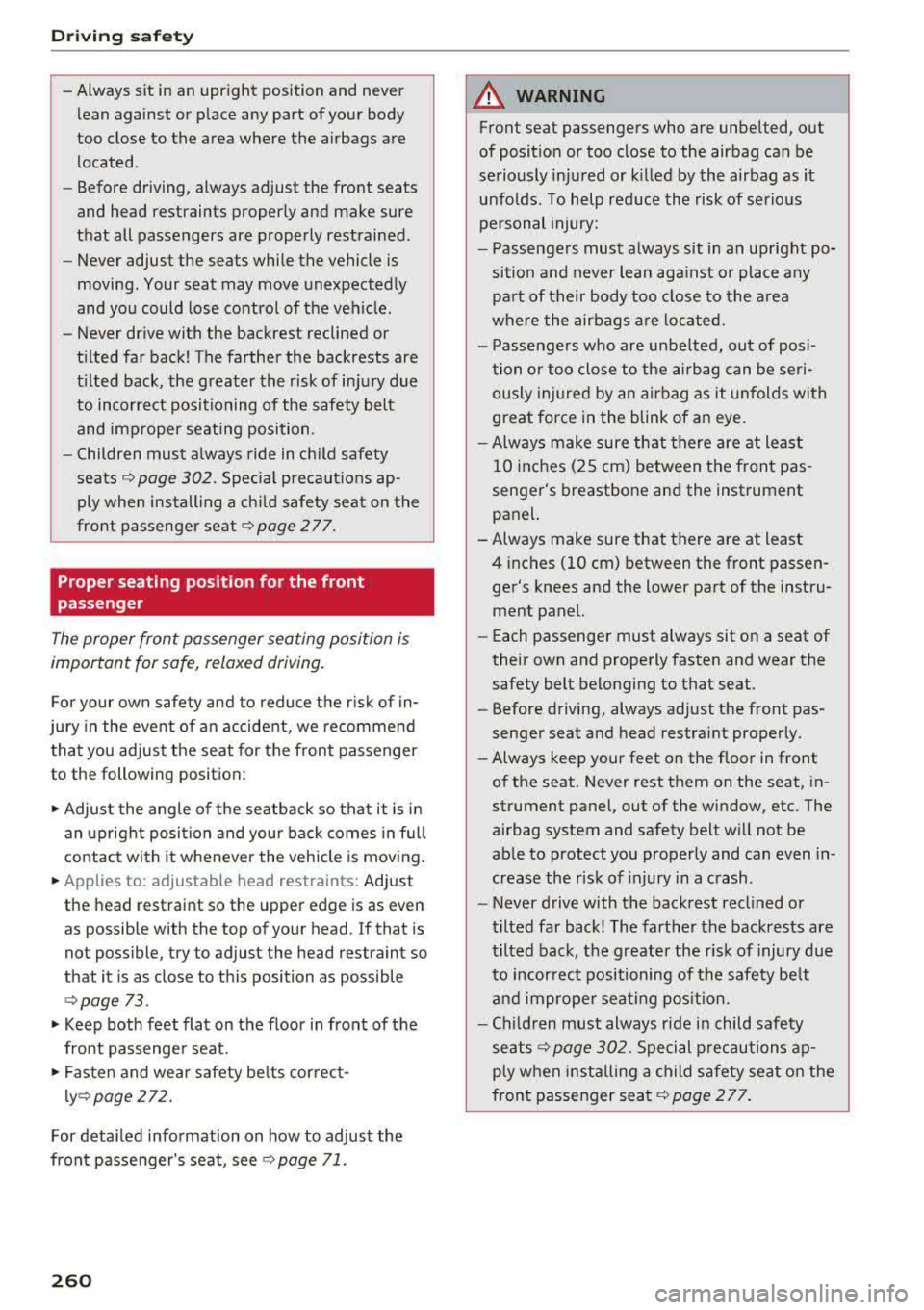
Driving safety
-Always sit in an upright position and never
lean against or place any part of your body
too close to the area where the airbags are located .
- Before driving, always adjust the front seats
and head restraints properly and make sure
that all passengers are properly restrained .
- Never adjust the seats while the vehicle is
moving . Your seat may move unexpectedly
and you could lose control of the vehicle.
- Never drive with the backrest reclined or
tilted far back! The farther the backrests are
tilted back, the greater the risk of injury due
to incorrect positioning of the safety belt and improper seating position .
- Children must always ride in child safety
seats
c::> page 302 . Special precautions ap
ply when installing a child safety seat on the
front passenger seat
<=:> page 277 .
Proper seating position for the f ront
passenger
The proper front passenger seating position is
important for safe, relaxed driving.
For your own safety and to reduce the risk of in
jury in the event of an accident, we recommend
that you adjust the seat for the front passenger
to the following position:
.. Adjust the angle of the seatback so that it is in
an upright position and your back comes in full
contact with it whenever the vehicle is moving.
.. Applies to: adjustable head restraints: Adjust
the head restraint so the upper edge is as even
a s possible with the top of your head . If that is
not possible, try to adjust the head restraint so
that it is as close to this position as possible
c::> page 73 .
.. Keep both feet flat on the floor in front of the
front passenger seat.
.. Fasten and wear safety belts correct
ly <=:> page 2 72.
For detailed information on how to adjust the
front passenger's seat, see
<=:> page 71.
260
A WARNING ,_
Front seat passengers who are unbelted, out
of position or too close to the airbag can be
seriously injured or killed by the airbag as it
unfolds. To help reduce the risk of serious
personal injury:
- Passengers must always sit in an upright po
sition and never lean aga inst or place any
part of their body too close to the area
where the airbags are located.
- Passengers who are unbelted, out of posi
tion or too close to the airbag can be seri
ously injured by an airbag as it unfolds with
great force in the blink of an eye.
- Always make sure that there are at least
10 inches (25 cm) between the front pas
senger's breastbone and the instrument
panel.
- Always make sure that there are at least 4 inches (10 cm) between the front passen
ger's knees and the lower part of the instru
ment panel.
- Each passenger must always sit on a seat of
their own and properly fasten and wear the
safety belt belonging to that seat.
- Before driving, always adjust the front pas
senger seat and head restraint properly.
- Always keep your feet on the floor in front
of the seat. Never rest them on the seat, in
strument panel, out of the window, etc . The
airbag system and safety belt will not be
able to protect you properly and can even in
crease the risk of injury in a crash .
- Never drive with the backrest reclined or
tilted far back! The farther the backrests are
tilted back, the greater the r isk of injury due
to incorrect positioning of the safety be lt
and improper seat ing position.
- Ch ildren must always ride in child safety
seats
c::> page 302. Special precautions ap
ply when installing a child safety seat on the
front passenger seat
c::> page 2 77.
Page 262 of 409
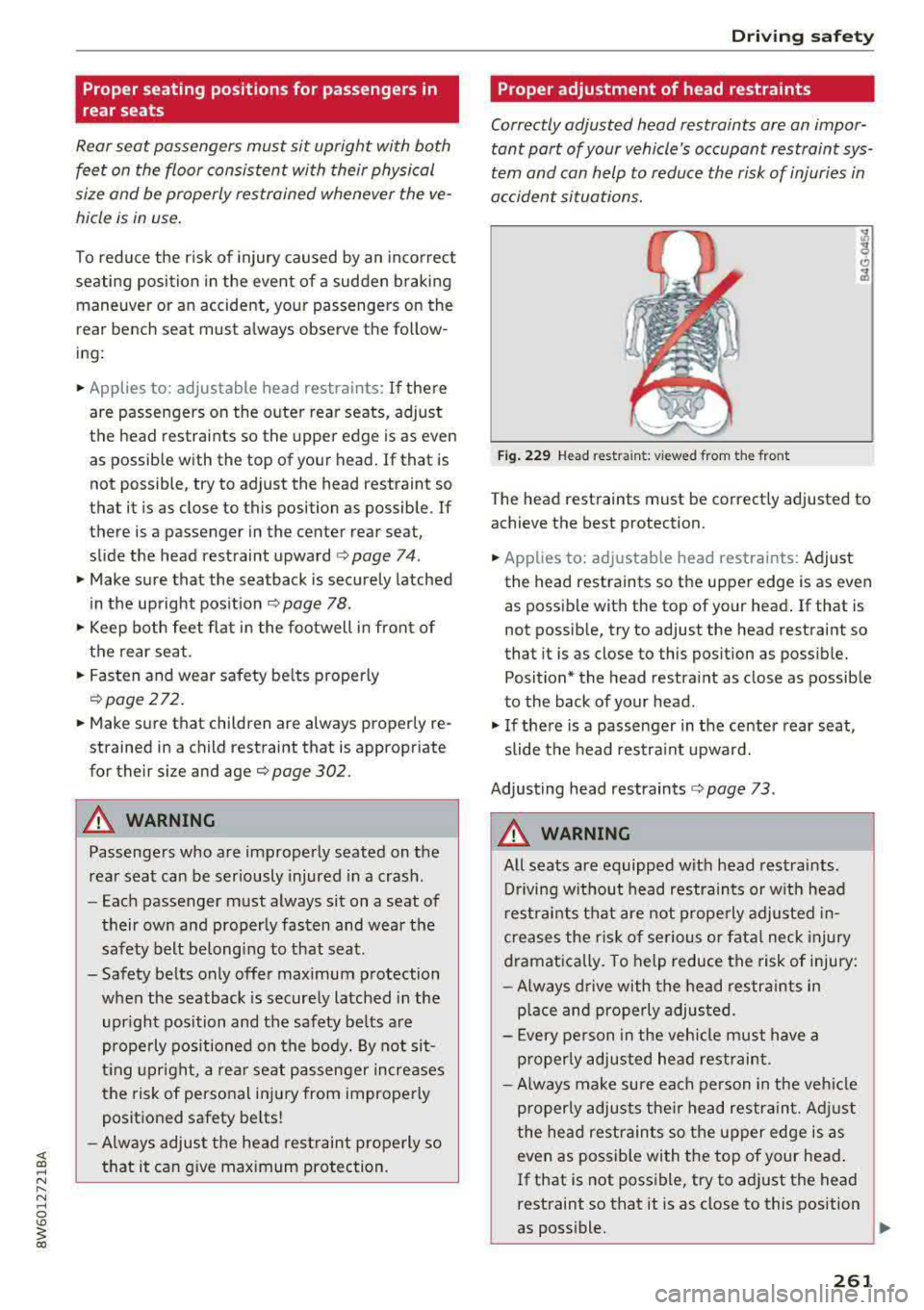
Proper seating positions for passengers in
rear seats
Rear seat passengers must sit upright with both
feet on the floor consistent with their physical
size and be properly restrained whenever the ve
hicle is in use.
To reduce the r isk of injury caused by an incorrect
seating position in the event of a sudden b raking
maneuver or an accident, your passengers on the
rear bench seat must a lways obse rve the follow
ing:
• Applies to: adjustable head restraints: If there
are passengers on the outer rear seats, adjust
the head restraints so the upper edge is as even
as possible with the top of your head . If that is
not possible, try to adjust the head restraint so
that it is as close to this position as possible. If
there is a passenger in the center rear seat,
slide the head restraint upward
r=> page 74 .
• Make sure that the seatback is sec urely latched
in the upright position
r=> page 78.
• Keep both feet flat in the footwell in front of
the rear seat .
• Fasten and wear safety be lts properly
r=> page 272 .
• Make sure that children are always properly re
strained in a child restraint that is appropriate
for their size and
ager=> page 302 .
_&. WARNING
Passengers who are improperly seated on the
rea r seat can be ser iously injured in a crash.
- Each passenger must always sit on a seat of
their ow n and properly fasten and wear the
safety belt be long ing to that seat.
- Safety belts only offer maximum p rotection
when the seatback is securely latched in the
upr ight position and the safety be lts a re
prope rly positioned on the body. By not sit
t ing upright, a re ar sea t passenger increases
the risk of personal inj ury from improperly
posit ioned safety be lts !
- Always adjust the head rest raint properly so
that it ca n give max imum protection.
Dr iving safety
Proper adjustment of head restraints
Correctly adjusted head restraints are an impor
tant part of your vehicle's occupant restraint sys
tem and can help to reduce the risk of injuries in
accident situations.
F ig . 229 Head restra int: v iewed from t he front
The head rest raints must be correctly adjusted to
achieve the best protection.
• Applies to: adjustable head restraints: Adjust
the head restraints so the upper edge is as even
as possible with the top of your head .
If that is
not possib le, try to adjust the head restraint so
that it is as close to this pos ition as poss ible.
Position* the head restra int as close as possible
to the back of your head .
• If the re is a passenger in the center rear seat,
slide the head restra int upward.
Adjusting head restraints
r=> page 73 .
_&. WARNING
-All seats are eq uipped with head restraints .
Driving w ithout head restraints or w it h head
r est raints t hat are not prope rly adjusted in
creases the r is k of se rious or fata l neck injury
dramat ically. To help reduce the risk of injury:
- Always d rive with the head restra ints in
p la ce and pro perly adjus ted.
- E very pe rson in the veh icle must have a
p roper ly adjusted hea d restraint.
- Always make sure each person in the veh icle
p roperly adjusts the ir he ad restrain t. Adj ust
the hea d restrain ts so the upper edge is as
even as possible wi th the top of your head .
If that is not poss ible, try to ad just the head
restraint so that it is as close to this position
as poss ible.
-
261
Page 263 of 409
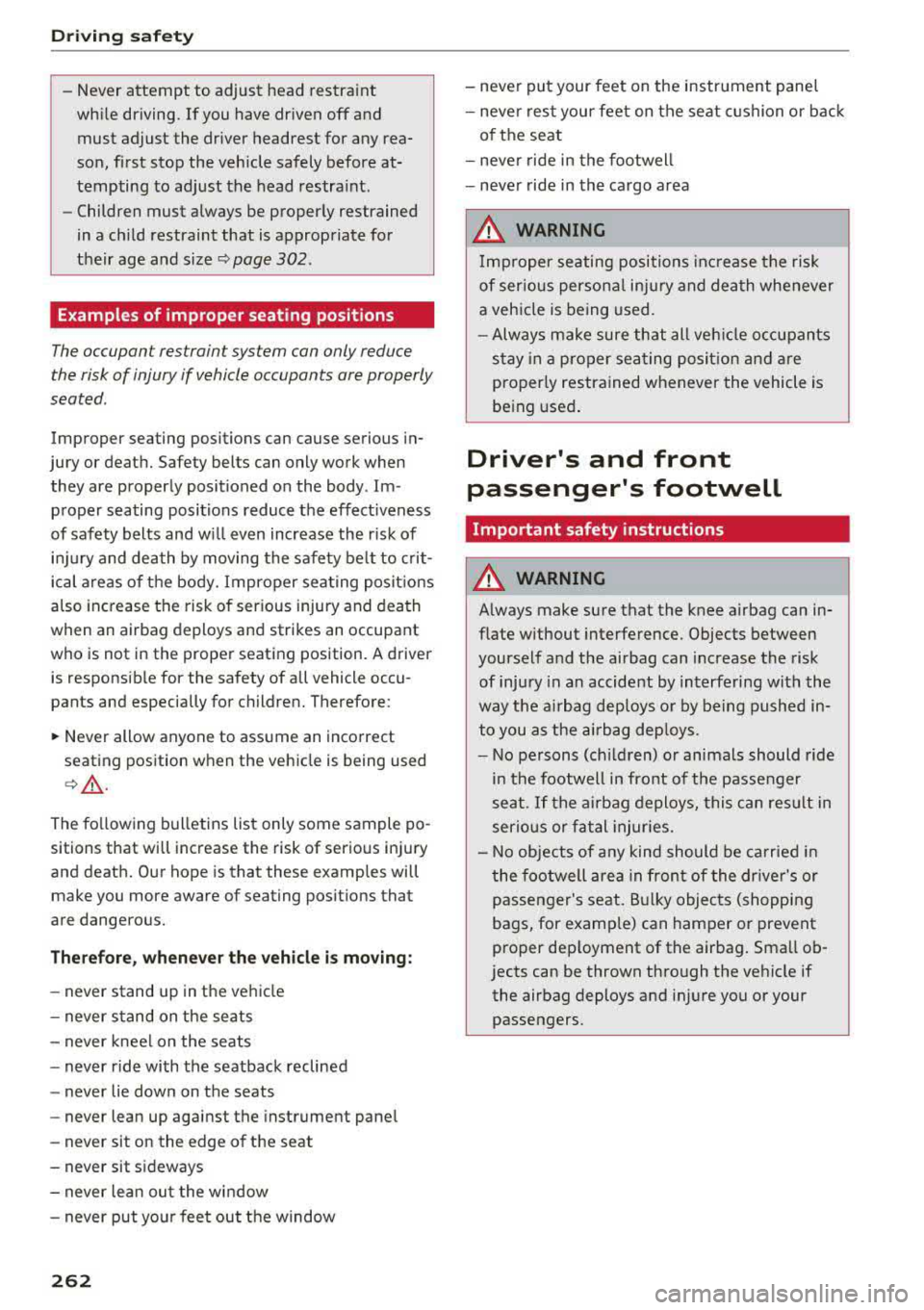
Driving sa fe ty
-Never attempt to adjust head restraint
wh ile driving. If you have dr iven
off and
must adjust the driver headrest for any rea
son, first stop the vehicle safely before at
tempting to adjust the head restra int.
- Children must always be properly restrained
in a child restraint that is appropriate for
their age and size
¢ page 302.
Examples of improper seating positions
The occupant restraint system can only reduce
the risk of injury if vehicle occupants are properly
seated .
Improper seating positions can cause serious in
jury or deat h. Safety belts can only work when
they are properly positioned on the body . Im
proper seating positions reduce the effect iveness
of safety belts and w ill even increase the r isk of
i njur y and dea th by moving the safety be lt to crit
ical areas of the body. Impro per sea ting posit ions
a lso increase the risk of ser ious injury and dea th
when an airbag deploys and strikes an occupant
who is not in the proper seat ing position. A driver
is responsib le for the safety of all vehicle occu
pants and especially for children. Therefore :
~ Never allow anyone to assume an incorrect
seat ing pos ition when the vehicle is being used
c> .&, .
The fo llowing bulletins list only some sample po
sitions that will increase the risk of serio us inj ury
and death. Our hope is that these examp les will
make you more aware of seating posit ions that
are dangerous.
The ref ore, when ever th e vehicle i s moving:
- never stand up in the ve hicle
- never s tand on the seats
- never knee l on the seats
- never r ide with the seatback reclined
- never lie down on t he seats
- never lean up against the instrument pane l
- never sit on the edge of the seat
- never sit s ideways
- never le an out the w indow
- never put yo ur feet out the window
262
- never put your feet on the instrument panel
- neve r rest your feet on the seat c ushion or back
o f the seat
- neve r ride in the footwell
- neve r ride in the ca rgo area
A WARNING
I mp roper seating positions inc re ase the risk
of ser iou s personal inju ry and de ath whenever
a veh icle is being used.
- Always make sure that all veh icle occupants
s tay in a proper sea ting posit ion and are
pro perly restrained whenever the vehicle is
be ing used .
Driver's and front
passenger's footwell
Important safety instructions
A WARNING
A lways make sure that the knee airbag can in
flate w ithout interference. Objects between
yourself and the airbag can inc rease the risk
of injury in an accident by interfering with the
way the ai rbag dep loys o r by being pushed in
to you as the airbag dep loys.
- No persons (ch ild ren) or animals should ride
in the footwell in front of the passenger
seat . If the airbag deploys, this can res ult in
serio us or fat al injuries.
- No objects of any kind should be carried i n
the footwell area in front of the dr iver's or
passenger's seat. Bu lky objects (shopping
bags, for examp le) can hamper or prevent
proper dep loyment of the airbag . Sma ll ob
jects can be thrown thro ugh the vehicle if
the airbag deploys and injure you or your passengers.
Page 264 of 409
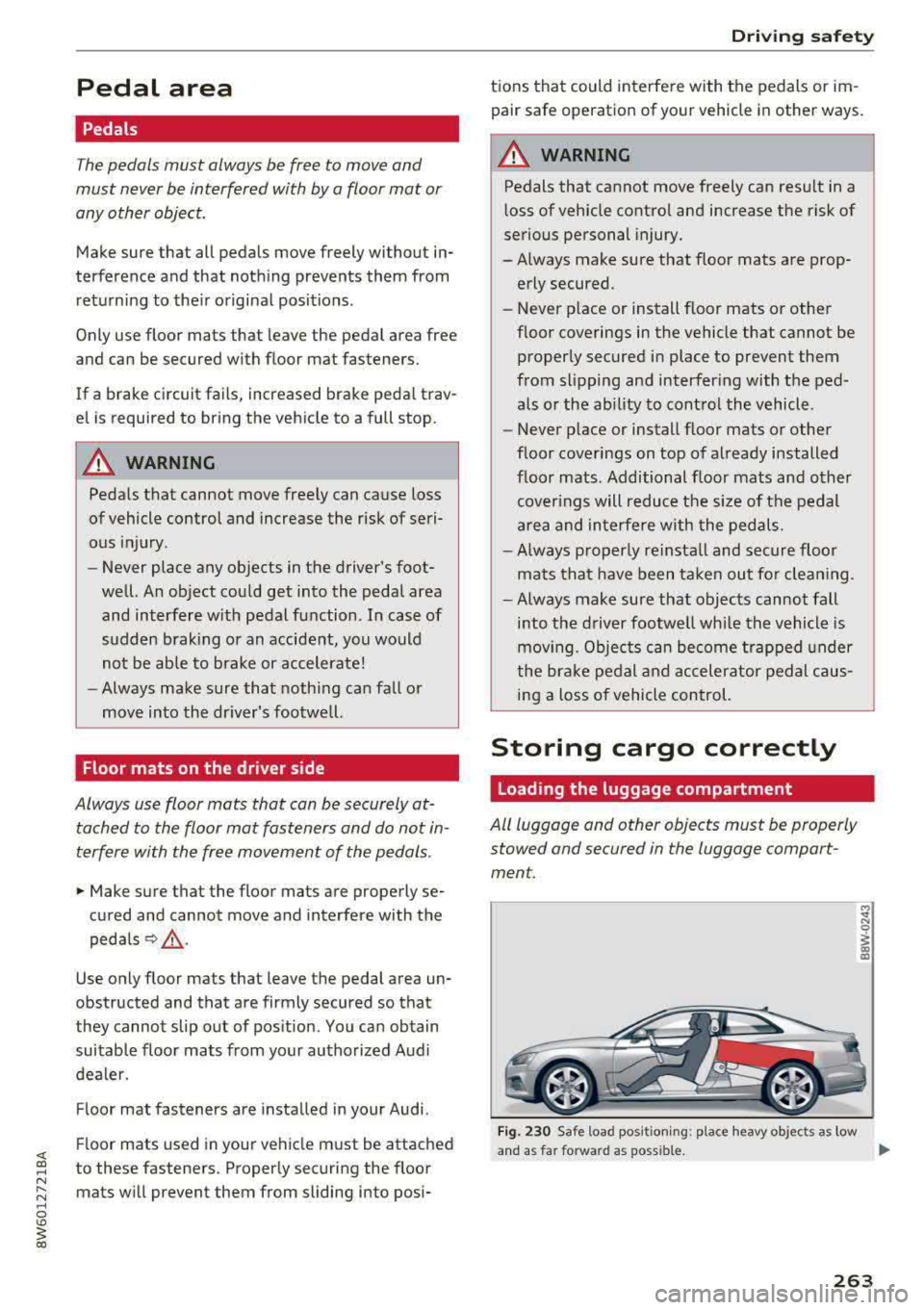
Pedal area
Pedals
The pedals must always be free to move and
must never be interfered with by a floor mat or
any other object.
Make sure that all pedals move freely without in
terference and that noth ing prevents them from
returning to their original positions .
Only use floor mats that leave the pedal area free
and can be secured with floor mat fasteners.
If a brake circuit fails, increased brake pedal trav
e l is required to bring the vehicle to a full stop.
A WARNING
Pedals that cannot move freely can cause loss
of vehicle control and increase the risk of seri
ous injury.
- Never place any objects in the driver's foot
well. An object could get into the pedal area and interfere w ith pedal function. In case of
sudden braking or an accident, you would not be ab le to brake or accelerate!
-Always make sure that nothing can fall or move into the dr iver's footwe ll.
Floor mats on the driver side
Always use floor mats that can be securely at
tached to the floor mat fasteners and do not interfere with the free movement of the pedals .
... Make sure that the floor mats are properly se
cured and cannot move and interfere with the
pedals
Q .&_ .
Use only floor mats that leave the pedal area un
obstructed and that are firmly secured so that
they cannot slip out of pos it ion . You can obtain
suitable floor mats from your authorized Audi
dealer.
Floor mat fasteners are installed in your Audi .
Fl oor mats used in your vehicle must be attached
to these fasteners. Properly securing the floor mats will prevent them from sliding into posi-
Driving safety
tions that could interfere with the pedals or im
pair safe operation of your vehicle in other ways.
.&_ WARNING
-
Pedals that cannot move freely can res ult in a
l oss of vehicle control and increase the risk of
serious personal injury.
-Always make sure that floor mats are prop
erly secured.
- Never p lace or install floor mats or other
f loor coverings in the vehicle that cannot be
proper ly secured in place to prevent them
from slipping and interfer ing with the ped
als o r the ab ility to control the vehicle.
- Never p lace or install floor mats or other
f loor cove rings on top of already installed
floor mats . Additional floor mats and other
cover ings will reduce t he si ze of the pedal
a rea and in terfere with the pedals.
- Always p roperly re insta ll and secure floor
mats that have been take n out fo r clean ing .
- Always make sure that objects cannot fall
into the d river footwell whi le the vehicle is
mov ing. Objec ts can become trapped under
the brake pedal and accelerator pedal caus
ing a loss of vehicle control.
Storing cargo correctly
Loading the luggage compartment
All luggage and other objects must be properly stowed and secured in the luggage compart
ment.
F ig. 230 Safe load positio ning: place heavy objects as low
a n d as far forward as poss ible.
IJI,-
263
Page 265 of 409
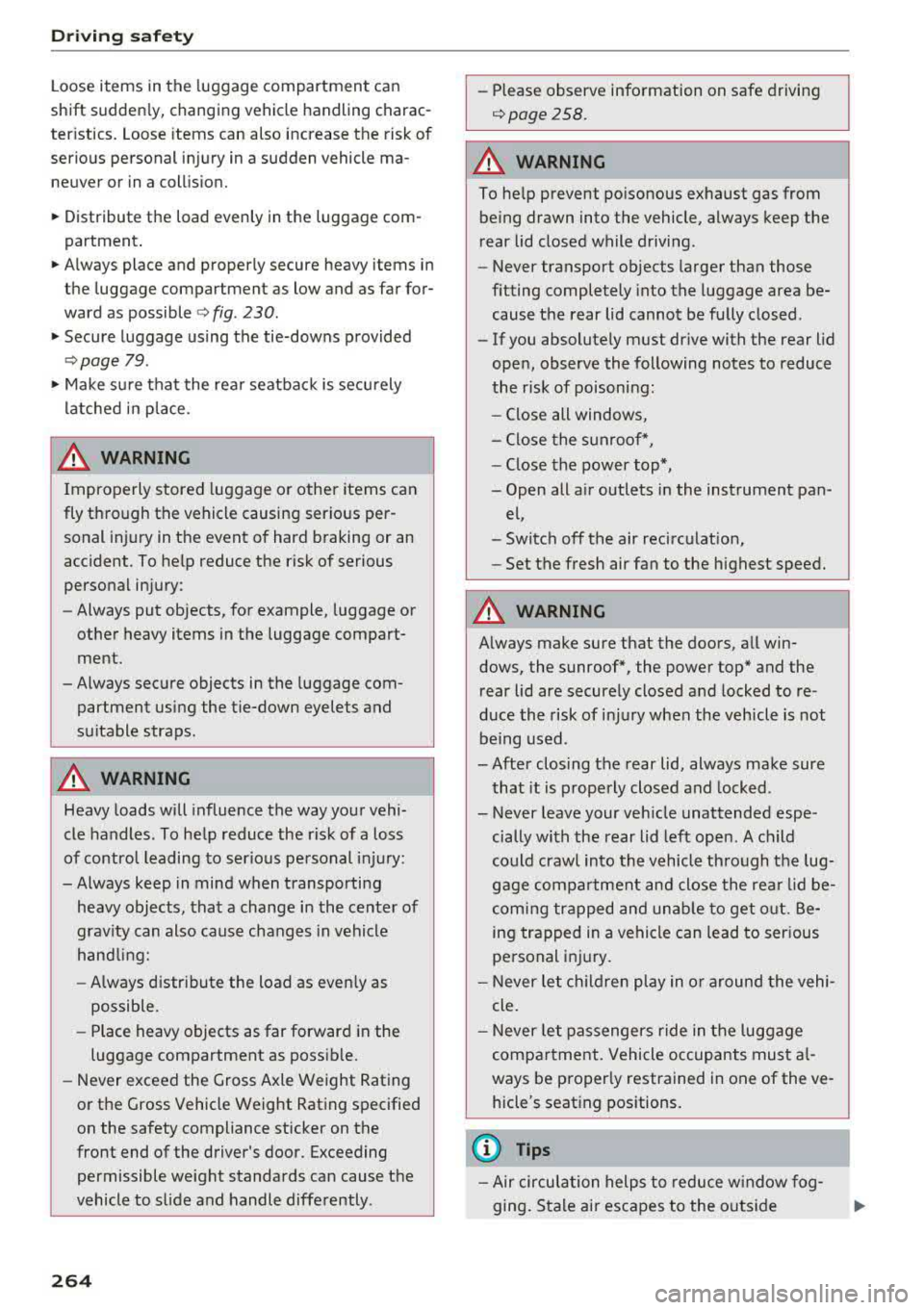
Driving sa fe ty
Loose items in the luggage compartment can
shift s udden ly, changing vehicle handling charac
ter istics . Loose items can also increase the risk of
serious personal in jury in a sudden vehicle
ma
neuver or in a coll is ion.
.,. Distribute the load evenly in the luggage com
partment .
.,. Always place and properly secure heavy items in
the luggage compartment as low and as far for
ward as possible
c> fig . 230 .
.,. Secure luggage us ing the tie-downs provided
¢ page 79 .
.,. Make su re that the rea r seatbac k is securely
latched in place .
A WARNING
Improperly stored luggage or othe r items can
fly through the vehicle causing serious per
sonal injury in the event of hard braking or an
accident . To help reduce the risk of serious
personal injury :
- Always put objects, for example, luggage or
other heavy items in the luggage compart
ment.
- Always sec ure objects in the luggage com
partment using the tie-down eyelets and
s u itable straps.
A WARNING
Heavy loads will influence the way your vehi
cle handles . To he lp reduce the r isk of a loss
of contro l leading to serious pe rsonal i njury:
- Always keep in mind when transporting heavy objects, that a change i n the center of
grav ity can also cause changes in vehicle
hand ling:
- Always distr ibute the load as even ly as
possible.
- Place heavy objects as far forward in the
luggage compartment as poss ible.
- Never exceed the Gross Axle Weight Rating
o r the Gross Vehicle Weight Rating specified
on the safety compliance sticker on the
front end of the driver's door. Exceeding permissible weight standards can cause the
vehicle to s lide and handle diffe rently .
264
-Please observe info rmation on safe driving
¢page 258 .
A WARNING
To he lp prevent po isonous exhaust gas from
being drawn into the vehicle, always keep the
rear lid closed while driving.
- Never transport objects larger than those
fitting completely into the luggage area be
cause the rear lid cannot be fully closed .
- If you absolutely must dr ive with the rear lid
open, observe the following notes to reduce
the risk of poisoning :
- C lose all windows,
- Close the s unroof*,
- Close the power top*,
- Open all a ir outlets in the instrument pan -
el,
- Switch off the air reci rculat ion,
- Set the fresh air fan to the highest speed.
A WARNING
-
Always make sure that the doors, all win
dows, the sunroof*, the power top * and the
rear lid are securely closed and locked to re
duce the risk of in jury when the veh icle is not
being used.
-After clos ing the rear lid, always make sure
that it is properly closed and locked .
- Never leave your veh icle unattended espe
cially wi th the rear lid left ope n. A child
could crawl into th e vehicle th rough the lug
gage compa rtment and close the rea r lid be
comi ng trapped and u nable to ge t out. Be
ing trapped in a vehicle can lead to ser ious
pe rsonal inj ury.
- Never let c hild ren p lay in o r around the vehi
cle.
- Never let passenge rs ride in the luggage
comp artment. Vehicle occu pants mus t
al
ways be proper ly restrained in one of the ve
hicle's seat ing pos itions.
(D Tips
- Air circu lation helps t o reduce w indow fog
ging . Stale air escapes to the o uts ide
Page 266 of 409
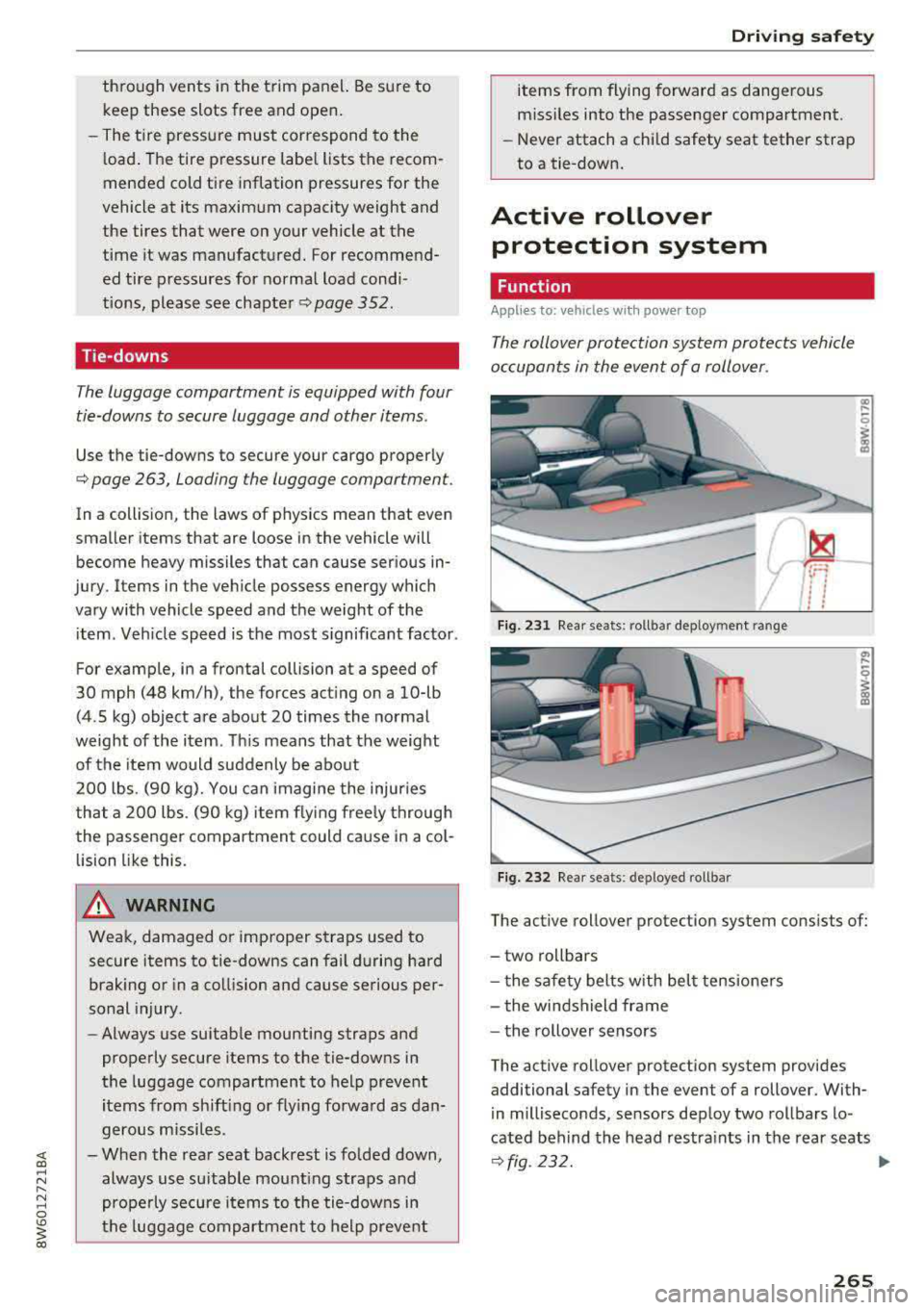
through vents in the trim panel. Be sure to keep these slots free and open .
- The t ire pressure must correspond to the
l oad . The tire pressure labe l lists the recom
mended cold tire inflation pressures for the
vehicle at its maximum capacity weight and
the tires that were on your vehicle at the
time it was manufactured. For recommend
ed tire pressures for normal load condi
tions, please see chapter
q page 3 52.
Tie-downs
The luggage compartment is equipped with four
tie-downs to secure luggage and other items .
Use the tie-downs to secure your cargo properly
q page 263, Loading the luggage compartment.
In a collision, the laws of physics mean that even
smaller items that are loose in the vehicle will
become heavy missiles that can cause serious in
jury . Items in the vehicle possess energy which
vary with vehicle speed and the weight of the
item . Veh icle speed is the most s ignificant factor .
For example, in a frontal collision at a speed of
30 mph (48 km/h), the forces acting on a 10-lb
(4.5 kg) object are about 20 times the normal
weight of the item . Th is means that the weight
of the item wo uld suddenly be abo ut
200 lbs . (90 kg). You can imagine the injuries
that a 200 lbs . (90 kg) item fly ing free ly through
the passenger compartment could cause in a col
lision l ike this .
A WARNING
Weak, damaged or improper straps used to
secure items to tie-downs can fail d uring hard
brak ing or in a collision and cause serious per
sonal injury.
- Always use su itab le mounting straps and
properly secure items to the tie-downs in
the luggage compartment to help prevent
items from shift ing or fly ing fo rwa rd as dan
gerous missiles.
- When the rear seat backrest is folded down, always use su itab le mount ing straps and
prope rly secure items to t he tie-downs in
the luggage compartmen t to help p reve nt
-
Dr iving safety
items from flying forward as dangerous
miss iles into the passenger compartment .
- Never attach a chi ld safety seat tether strap
to a tie-down.
Active rollover protection system
Function
Applies to: veh icles w ith power top
The rollover protection system protects vehicle
occupants in the event of a rollover .
Fig. 231 Rear seats : rollbar deployment range
Fig. 232 Rear seats : deployed rollbar
The active rollover protection system consists of:
- two rollbars
- t he safe ty belts with bel t tensione rs
- the wi ndshield frame
- the rollover senso rs
The active rollover protection system provides additional safety in the event of a rollover. With
i n milliseconds, sensors deploy two rollbars lo
cated behind the head restra ints in the rear seats
¢ fig . 232. 11iJJ,
265
Page 267 of 409
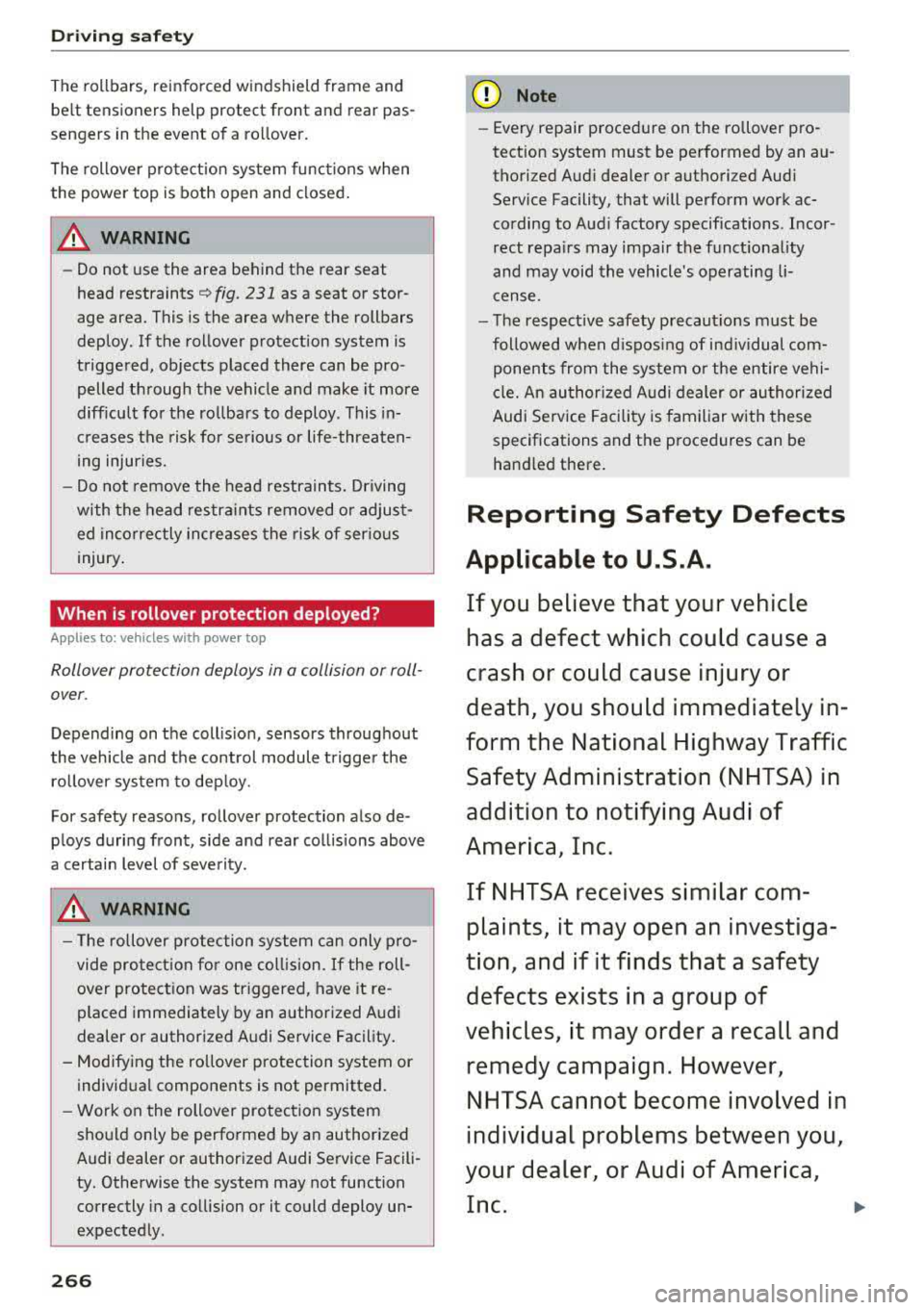
Driving safety
The rollbars, reinforced windshield frame and
belt tensioners help protect front and rear pas
sengers in the event of a rollover.
The rollover protection system functions when
the power top is both open and closed.
A WARNING
-
- Do not use the area behind the rear seat
head restraints
c::> fig. 231 as a seat or stor
age area. This is the area where the rollbars deploy. If the rollover protection system is
triggered, objects placed there can be pro
pelled through the vehicle and make it more
difficult for the rollbars to deploy . This
in
creases the risk for serious or life-threaten
ing injuries.
- Do not remove the head restraints. Driving
with the head restraints removed or adjust
ed incorrectly increases the risk of serious
injury.
When is rollover protection deployed?
A ppl ies to: ve hicles w ith power to p
Rollover protection deploys in a collision or roll
over .
Depending on the collision, sensors throughout
the vehicle and the control module trigger the rollover system to deploy.
For safety reasons, rollover protection also
de
ploys during front , side and rear collisions above
a certain level of severity.
A WARNING
- The rollover protection system can only pro
vide protection for one collision.
If the roll
over protection was triggered, have it re
placed immediately by an authorized Audi
dealer or authorized Audi Service Facility.
- Modifying the rollover protection system or individual components is not permitted.
- Work on the rollover protection system
should only be performed by an authorized
Audi dealer or authorized Audi Service Facili
ty. Otherwise the system may not function
correctly in a collision or it could deploy
un
expectedly .
266
(D Note
-Every repair procedure on the rollover pro
tection system must be performed by an au
thori zed Audi dealer or authori zed Audi
Service Facility, that will perform work ac
cording to Audi factory specifications . Incor
rect repairs may impair the functionality
and may void the vehicle's operating
li
cense .
- The respective safety precautions must be
followed when disposing of individual com ponents from the system or the entire vehi
cle. An authorized Audi dealer or authorized
Audi Service Facility is familiar with these
specifications and the procedures can be
handled there.
Reporting Safety Defects
Applicable to U.S.A.
If you believe that your vehicle
has a defect which could cause a
crash or could cause injury or
death, you should immediately in
form the National Highway Traffic Safety Administration (NHTSA) in
addition to notifying Audi of
America, Inc.
If NHTSA receives similar com
plaints, it may open an investiga
tion, and if it finds that a safety
defects exists in a group of
vehicles, it may order a recall and
remedy campaign. However,
NHTSA cannot become involved in
individual problems between you,
your dealer, or Audi of America, Inc.
..,.
Page 268 of 409
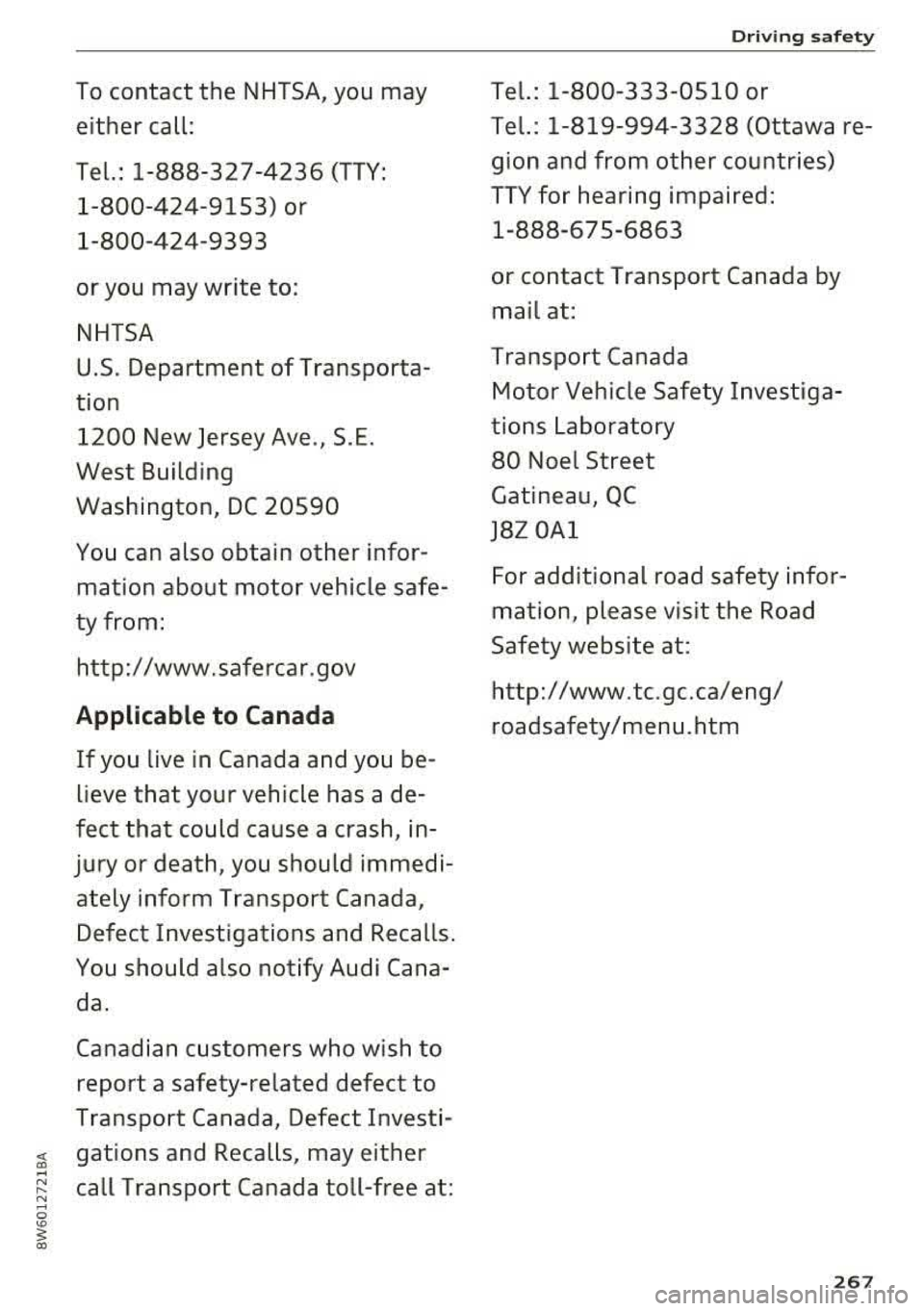
To contact the NHTSA, you may either call:
Tel.: 1-888 -327 -4236 (TTY:
1 -800-424-9153) or
1-800-424-9393
or you may write to:
NH TSA
U .S. Department of Transporta
tion 1 200 New Jersey Ave., S .E.
West Building
Washington, DC 20590
Yo u can also obtain other infor
mation about motor vehicle safe
ty from:
http:/ /www.safercar .gov
Applicable to Canada
If you live in Canada and you be
lieve that your vehicle has a de
fect that could cause a crash , in
jury or death, you should immedi
ately inform Transport Canada,
Defect Investigations and Recalls .
You should also notify Audi Cana da .
Canadian customers who wish to
report a safety-related defect to
Transport Canada, Defect Investi-
;a gations and Recalls, may either ..-<
~ call Transport Canada to ll-free at: ..-< 0
"' 3'; a:,
Driving safety
T el. : 1-800-333-0510 or
T el. : 1-819-994-3328 (Ottawa re
gion and from other countries)
TTY for hearing impaired: 1 -888-67 5-6863
or contact Transport Canada by mai l at :
T ranspo rt Canada
Motor Vehicle Safety Investiga
tions Laboratory
80 Noel Street
Gatineau, QC
J 8 Z 0A l
For addit ional road safety infor
mation, please visit the Road
Safety website at:
http:/ /www.tc.gc.ca/eng/
roadsa fety/menu .htm
2 6 7
Page 269 of 409
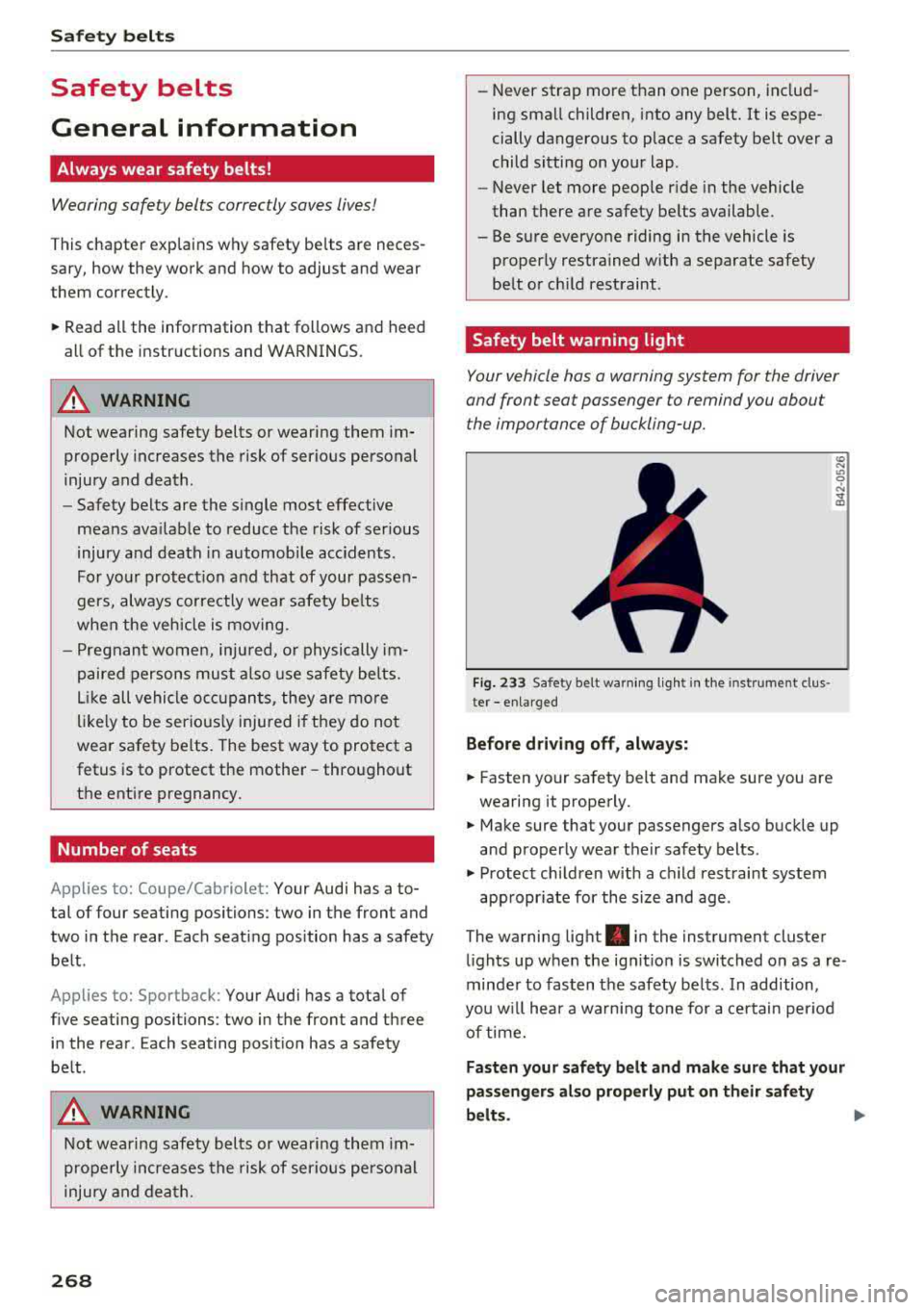
Safety belt s
Safety belts
General information
Always wear safety belts!
Wearing safety belts correctly saves lives!
This chapter explains why safety be lts are neces
sary, how they work and how to adjust and wear
them correctly .
.. Read all the information that follows and heed
all of the instructions and WARNINGS.
&_ WARNING
Not wearing safety belts or wearing them im
properly increases the risk of serious personal
injury and death.
- Safety belts are the s ingle most effective
means ava ilable to reduce the risk of serious
injury and death in automobile accidents.
For your protect ion and that of your passen
gers, always co rrectly wear safety be lts
when the vehicle is moving .
- Pregnant women, injured, o r physically im
paired persons must a lso use safety belts.
L ik e all vehicle occ upants, they are mo re
likely to be serio usly injured i f they do not
wea r safety be lts. The best way to protect a
fetus is to protect the mother -thro ughout
the ent ire pregnancy .
Number of seats
Applies to: Coupe/Cab riolet: Your Audi has a to
tal of four seating positions: two in the front and
two in the rear. Each seat ing position has a safety
belt .
App lies to: Sportback: Your Audi has a total of
five seating positions: two in the front and three
in the rear . Each seating posit ion has a safety
belt .
&_ WARNING
Not wea ring safety belts or wearing them im
properly increases the risk of ser io us personal
injury and dea th.
268
- Never strap more than one person, includ
ing small children, into any belt. It is espe
cially dangerous to place a safety be lt over a
child sitting on your lap .
- Never let more people r ide in the vehicle
than there are safety be lts available.
- Be sure everyone riding in the vehicle is
proper ly restrained with a separate safety
be lt or ch ild restraint .
Safety belt warning light
Your vehicle has a warning system for the driver
and front seat passenger to remind you about the importance of buckling-up.
Fi g. 233 Safety belt warn ing lig ht in th e in st rument clus
ter -enlarged
Befor e dri ving off , alway s:
.. Fasten your safety belt and make sure you are
wearing it properly .
and properly wear the ir safety belts .
.. Protect children with a ch ild restraint system
app ropr iate for the size and age .
The warning light . in the instrument cluster
l ights up when the ig nition is switched on as a re
minder to fasten t he safety be lts . In addition,
you w ill hea r a wa rning tone for a ce rtain per iod
of time.
Fasten your saf ety b elt and make sure that your
pas sengers al so prop erly put on th eir safety
belts.
Page 270 of 409
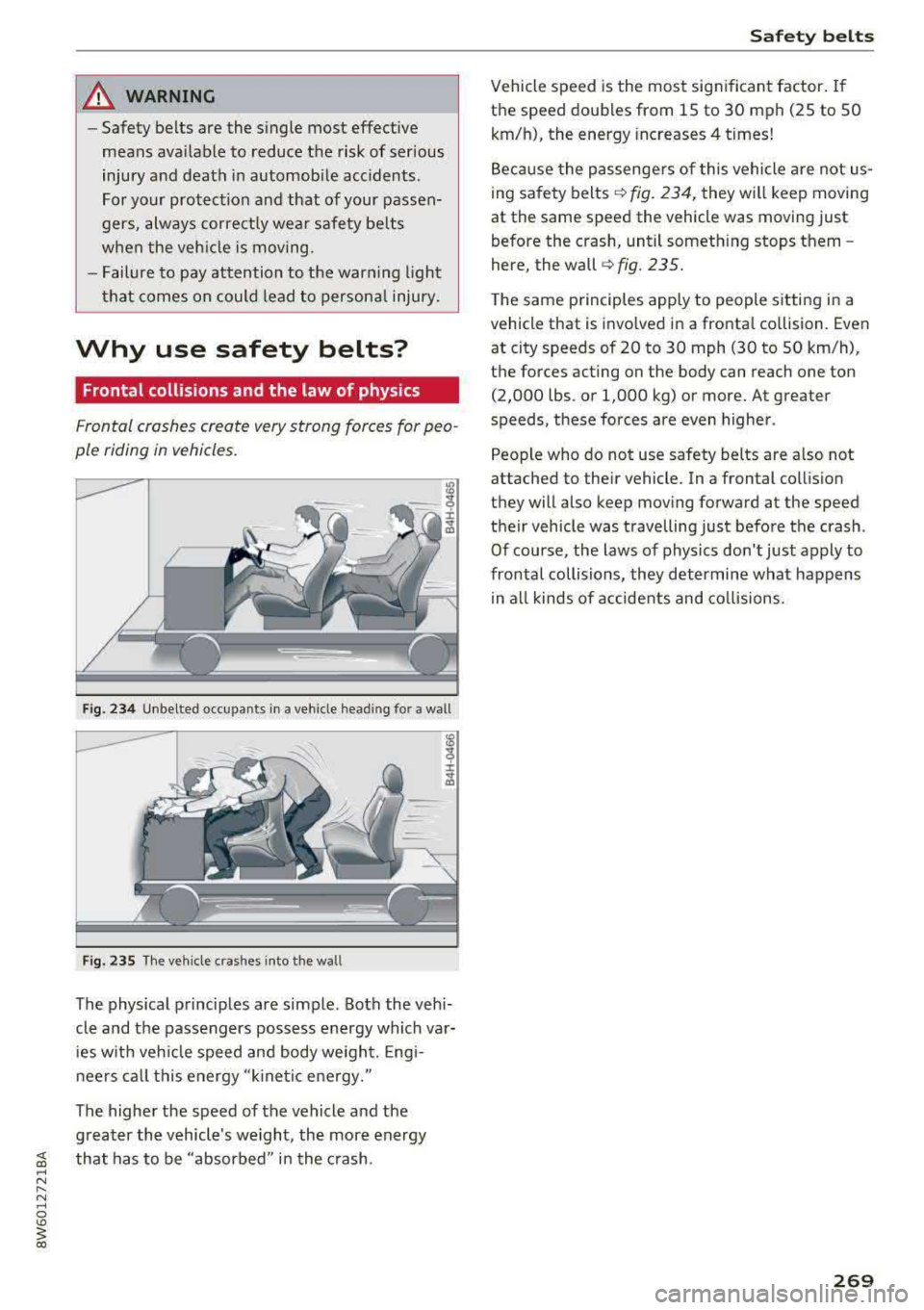
_& WARNING
-Safety belts are the single most effective
means availa ble to r educe the ris k of ser ious
injury and death in automobile accidents .
For your protection and that of your passen
gers, always correctly wea r safety be lts
when the veh icle is moving .
- Failure to pay attention to the warn ing light
that comes on could lead to persona l injury.
Why use safety belts?
Frontal collisions and the law of physics
Frontal crashes create very strong forces for peo
ple riding in vehicles.
Fig. 2 34 Unbelted occupants in a veh icle head ing for a wall
Fig. 23 5 The veh icle crashes into the wa ll
The physical principles are simple . Both the vehi
cle and the passengers possess e nergy which va r
ies w ith veh icle speed and body weigh t. Engi
n eers ca ll this energy "ki ne tic e nergy."
The highe r the speed of the vehicle and the
g reater the vehicle 's we ight, the more energy
~ that has to be "absorbed " in the crash. ~ N ...... N ~ 0
'° ~ co
Safet y bel ts
Vehicle speed is the most significant factor . If
the speed doubles from 15 to 30 mph (25 to 50
km/h), the energy increases 4 times!
Because the passenge rs of this vehicle a re not us
ing sa fety belts
¢ fig . 234, they will keep moving
at the same speed the vehicle was moving just
before the crash, until someth ing stops them -
here, the wall
c:.-fig. 235.
T he same p rinciples apply to people sitting in a
vehicle that is invo lved in a fronta l co llision. Even
at city speeds of 20 to 30 mph (30 to 50 km/h),
the forces acting on the body can reach one ton (2,000 lbs . or 1,000 kg) or more. At greater
speeds, these forces are even higher .
People who do not use safety belts are a lso not
attached to the ir vehicle. In a frontal collis ion
they will also keep moving forward at the speed
their vehicle was travelling just before the crash .
Of course, the laws of physics don' t just apply to
frontal collisions, they determine what happens in all kinds of accide nts and co llisions.
269